#Kuniko Igawa
Photo

Isao Shirasawa, Chishu Ryu, Chieko Higashiyama, Setsuko Hara, Ichiro Sugai, Kuniko Miyake, and Zen Murase in Early Summer (Yasujiro Ozu, 1951)
Cast: Setsuko Hara, Chishu Ryu, Chikage Awashima, Kuniko Miyake, Ichiro Sugai, Chieko Higashiyama, Haruko Sugimura, Kuniko Igawa, Hiroshi Nihon'yanagi. Shuji Sano, Toyo Takahashi, Seiji Miyaguchi. Screenplay: Kogo Noda, Yasujiro Ozu. Cinematography: Yuharu Atsuta. Art direction: Tatsuo Hamada. Film editing: Yoshiyasu Hamamura. Music: Senji Ito.
Early Summer is the second of the "seasonal" films made by Yasujiro Ozu in what is now recognized as his peak postwar period. The first was Late Spring (1949), and they were followed by Early Spring (1956), Late Autumn (1960), The End of Summer (1961), and An Autumn Afternoon (1962). I mention this chiefly because the English-language titles confuse even Ozu's hard-core admirers, among whom I count myself. "Was that Early Summer or The End of Summer?" we find ourselves asking when we're talking about Ozu's films. The confusion is further compounded by the fact that four of them starred the marvelous Setsuko Hara. It also doesn't help that the name of her character in Early Summer is Noriko, which was the name of her characters in Late Spring and Tokyo Story (Ozu, 1953). So we have to remind ourselves that in Early Summer she is Noriko Mamiya, the unmarried 28-year-old daughter of Shukichi (Ichiro Sugai) and Shige Mamiya (Chieko Higashiyama). She lives with them as well as with her brother, Koichi (Chishu Ryu), and sister-in-law, Fumiko (Kuniko Miyake), and their two bratty sons. She also has a well-paying clerical job and a group of old girlfriends from her schooldays. So why does everyone, even her boss, want her to get married? When her boss starts arranging things with an old business friend of his, her family encourages the connection, even though she's never met the man and he's in his early 40s. Noriko has a mind of her own, however, and eventually surprises everyone -- perhaps even herself -- with her decision. It's a comedy-drama in which nothing exciting happens -- even key events like the search for the bratty boys when they decide to run away from home take place mostly off-screen -- but Ozu holds everything in such delicate suspension, allowing us to meditate on the relationships at length, that we get caught up in the everyday lives of the film's huge cast. There are some wonderful scenes between Noriko and her girlfriends, who share the kind of in-jokes that old friends everywhere have. Some of these are lost in translation, but even that reminds us of real life, when we're left out of a group's established routines. And sometimes the subtitles wittily help us out, finding equivalents for the hick accents Noriko and her friend adopt when talking about the possibility of moving from Tokyo to the country. Ozu and co-screenwriter Kogo Noda bring the characters to life in their private moments, as when Shukichi and Shige talk wistfully about the son who remained MIA after the war, or when they see a balloon floating ahead and reflect on how sad the child who lost it must be. No filmmaker had a profounder sense of the inner lives of people in their ordinary routine.
#Early Summer#Yasujiro Ozu#Isao Shirasawa#Chishu Ryu#Chieko Higashiyama#Setsuko Hara#Ichiro Sugai#Kuniko Miyake#Zen Murase
3 notes
·
View notes
Photo
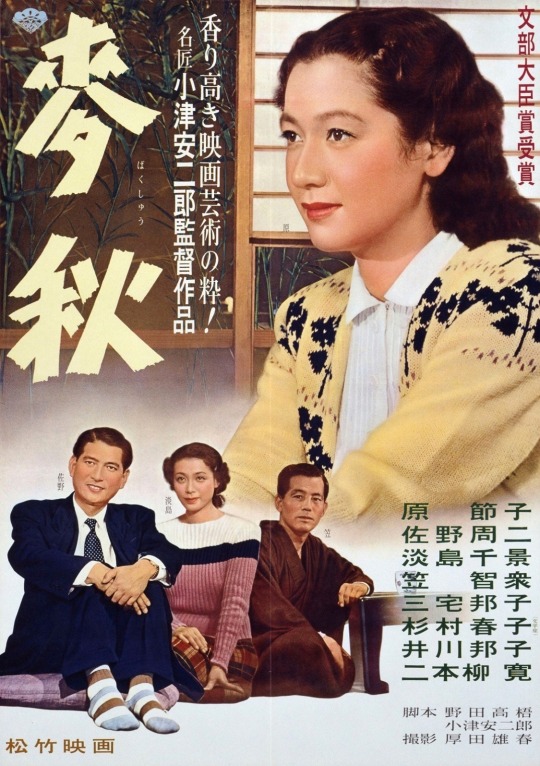



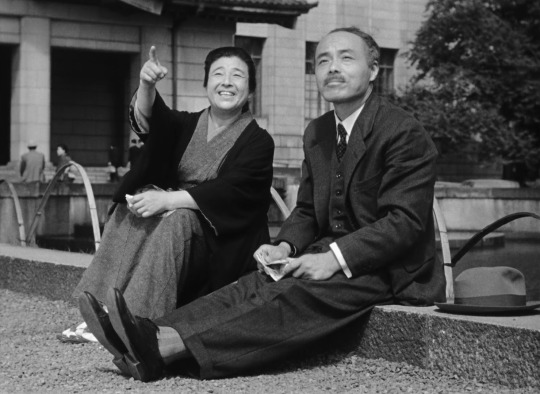
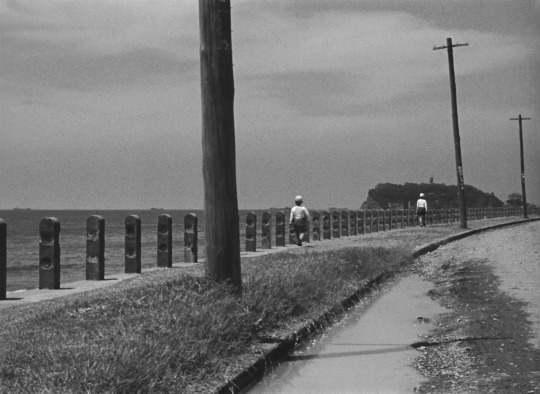

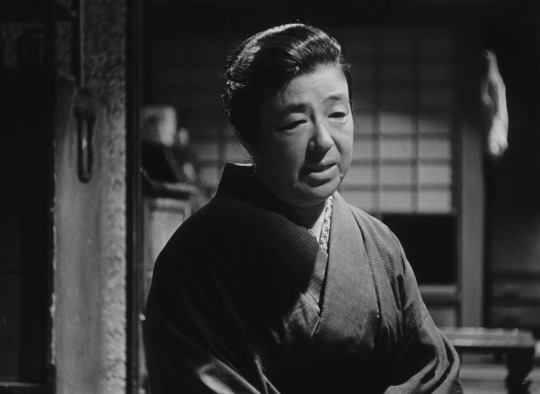
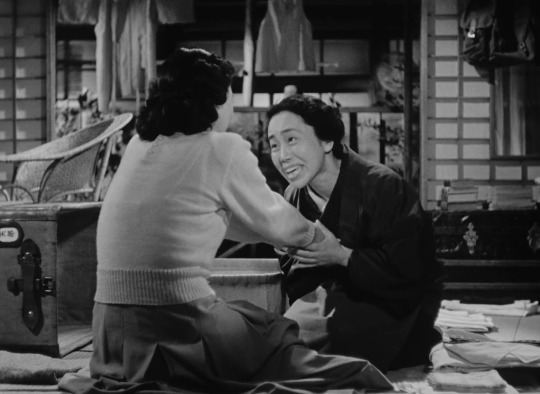

Early Summer / Bakushū (1951, Yasujirō Ozu)
麦秋 (小津安二郎)
5/23/21
#Early Summer#Yasujiro Ozu#Setsuko Hara#Chishu Ryu#Bakushu#Chikage Awashima#Kuniko Miyake#Ichiro Sugai#Haruko Sugimura#Chieko Higashiyama#Kuniko Igawa#Toyo Takahashi#Shuji Sano#Hiroshi Nihon'yanagi#50s#Japanese#Japanese Golden Age#gendaigeki#families#marriage#postwar#siblings#girlfriends#children#Tokyo
7 notes
·
View notes
Photo

Early 1940s: Igawa Kuniko (井川邦子) 1923-2012, Japanese Actress
139 notes
·
View notes
Text
Bakushū [Early Summer]
(Japan 1951)
After a presentation of shorts, the George Eastman Museum kicked off its third annual Nitrate Picture Show with a Japanese drama, Yasujirō Ozu’s quiet and gracefully understated Bakushū [麦秋]. In the context of midcentury Japan, Ozu explores the generational clash between tradition and progress, and both the possibilities and the casualties brought on by the latter. Opening with…
View On WordPress
#Bakushū#Chieko Higashiyama#Chikage Awashima#Chishū Ryū#Early Summer#麦秋#Haruko Sugimura#Hiroshi Nihon&039;yanagi#Ichirō Sugai#Isao Shirosawa#Janus Films#Kokuten Kōdō#Kuniko Igawa#Kuniko Miyake#Nitrate Picture Show#Seiji Miyaguchi#Setsuko Hara#Shochiku Company Limited#Shūji Sano#Takeshi Yamamoto#The Voyager Company#Tokyo#Yasujirō Ozu#Zen Murase
0 notes
Text
"Your Lie in April" Stage Play Reveals New Cast and Promo Images
The ranks of the upcoming Your Lie in April stage play are growing, with five new cast members announced. Additionally, character one-shots of more of the main cast have been released.
Misato Kawauchi as Tsubaki Sawabe:
Masanari Wada as Ryouta Watari:
Shojiro Yokoi as Takeshi Aiza:
Haruka Yamashita as Emi Igawa:
Five new actors have also joined the cast:
Yuriko Ochiai: Takako Nakamura (Legend of the Millennium Dragon)
Akira Takayanagi: Shun Mikami (stage productions of Code Geass and Legend of the Galactic Heroes)
Nao Kashiwagi: Haruka Igarashi
Hiroko Seto: Kuniko Kodama (As You Say Mako)
Saki Arima: Ryoko Tanaka
The stage production of Your Lie in April is set to run from August 24 to September 3 at the AiiA 2.5 Theater Tokyo, and then at Osaka's Umeda Arts Theater from September 7-10.
Source: Anime! Anime!
-----
Kara Dennison is responsible for multiple webcomics, blogs and runs interviews for (Re)Generation Who and PotterVerse, and is half the creative team behind the OEL light novel series Owl's Flower. She blogs at karadennison.com and tweets @RubyCosmos.
1 note
·
View note
Photo

[Forum] Hiromi Tsuru (la voix de Bulma) nous a quitté [Seiyu] Hiromi Tsuru # Bloc TechniqueNom : TsuruPrénom : HiromiNom japonais : 鶴 ひろみDate de naissance : 29 mars 1960Lieu de naissance : Kanagawa, JaponDate de décès : 16 novembre 2017 (à 57 ans) à Tokyo, JaponMétier : SeiyūAgence : Aoni ProductionGroupe sanguin : APassions : Golf, Tennis # Doublages Animation 1970s The Story of Perrine (1978) (Perrine Paindavoine [debut])1980s Ohayō! Spank (1981) (Cat) Space Cobra (1982) (Sierra) Little Pollon (1982) (Selene, Goddess) Arcadia of My Youth: Endless Orbit SSX (1982) (Revi) The Kabocha Wine (1982) (Kanzaki, Yōko) Warrior of Love Rainbowman (1982) (Yōko Ohmiya) The Super Dimension Fortress Macross (1982) (Kim Kabirov) Kinnikuman (1983) (Natsuko Shōno, Girl A, Terryman (young) (Episode 11)) Lightspeed Electroid Albegas (1983) (Hotaru Mizuki) Miyuki (1983) (Miyuki Kashima) Stop!! Hibari-kun! (1983) (Rie Kawai) Nince (1984) (Yoko Takagi) Star Musketeer Bismark (1984) (Chyntia) Touch (1985) (Sachiko Nishio) Cat's Eye (1985) (Cathy, Akiko) Bosco Adventure (1986) (Unicorn) Dragon Ball (1986) (Bulma and Child Piccolo Jr.) Hikari no Densetsu (1986) (Miyako Kamijou) Maison Ikkoku (1986) (Asuna Kujou) Saint Seiya (1986) (Chameleon June, Mermaid Thetis) Esper Mami (1987) (Taeko Kuroyuki) Hiatari Ryōkō! (1987) (Keiko Seki) Tsuide ni Tonchinkan (1987) (Naoko Ibaraki) Kimagure Orange Road (1987) (Madoka Ayukawa) Anpanman (1988) (Dokin-chan) City Hunter 2 (1988) (Katharine) Dragon Ball Z (1989) (Bulma, Baby Trunks, Bra and West Kaiō-shin) Ranma ½ Nettōhen (1989) (Ukyo Kuonji and Kaori Daikoku)1990s Tsuyoshi Shikkari Shinasai (1992) (Keiko Igawa) Ghost Sweeper Mikami (1993) (Reiko Mikami) Dragon Ball GT (1996) (Bulma, Bra, Bulma's Descendant) Cyber Team in Akihabara (1998) (Hinako Hanakoganei, Petit Angel) Silent Möbius (1998) (Kiddy Phenil) Trigun (1998) (Meryl Stryfe) Kamikaze Kaito Jeanne (1999) (Jeanne D'Arc) Monster Rancher (1999) (Undine)2000s Gravitation (2000) (Mika Seguchi) Love Hina (2000) (Mrs. Maehara) Detective Conan (2000) (Kuniko Yamamoto) Samurai Girl: Real Bout High School (2001) (Madoka Mitsurugi) Great Dangaioh (2001) (Mrs. Midorikawa) Vampiyan Kids (2001) (Mama) Dragon Drive (2002) (Hideaki) Samurai Champloo (2004) (Shino/Kohaku) Yu-Gi-Oh! GX (2007) (Yubel's female voice) Porphy no Nagai Tabi (2008) (Isabella) One Piece (2009) (Shakuyaku) Dragon Ball Kai (2009) (Bulma, Baby Trunks, Bra and West Kaiō-shin)2010s Blue Exorcist (2011) (Michelle) Chibi Maruko-chan (2011) (Oyone (Second)) Saint Seiya Omega (2013) (Pallas) Dragon Ball Super (2015) (Bulma, Tights, Bra) Jeux Metal Gear Solid (Naomi Hunter) Metal Gear Solid 4: Guns of the Patriots (Naomi Hunter) Tekken Tag Tournament (Julia Chang) Tags : #personnalité #seiyu #Hiromi-Tsuru Lien vers la fiche : http://ift.tt/2jALO4a http://ift.tt/2hBIiSQ
0 notes
Photo
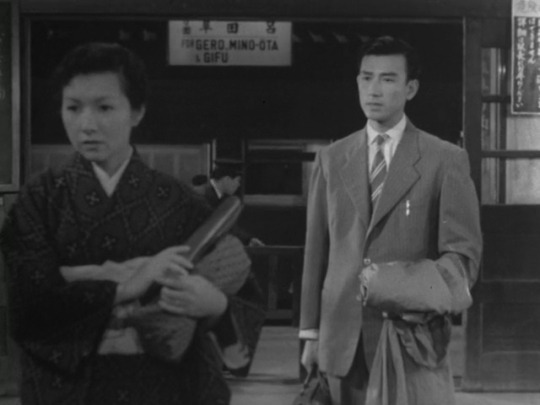
Hideko Takamine and Keiji Sada in The Tattered Wings (Keisuke Kinoshita, 1955)
Cast: Hideko Takamine, Keiji Sada, Takahiro Tamura, Teiji Takahashi, Akira Ishihama, Toshiko Kobayashi, Kuniko Igawa, Eijiro Yanaki, Takeshi Sakamoto. Screenplay: Keisuke Kinoshita, Zenzo Matsuyama. Cinematography: Hiroshi Kusuda. Art direction: Kazue Hirataka. Film editing: Yoshi Sugihara. Music: Chuji Kinoshita.
Keisuke Kinoshita's explorations of postwar domestic dilemmas include The Tattered Wings, in which Fuyuko (Hideko Takamine), a war widow, is torn between -- what else? -- love and duty. Before the war she was in love with Keizo Ishizu (Takahiro Tamura), but she was forced into a marriage with the older son of a wealthy distiller. Her husband was cruel and unfaithful, and he left her with a daughter when he was killed in the war. Meanwhile, her husband's younger brother, Shunsuke (Keiji Sada), has fallen in love with her. He's a nicer guy than his brother, but things get complicated when Keizo suddenly returns to town, paying a visit before he moves to a new job in far-off Hokkaido. Their meetings stir gossip in the town, some of it fed by Fuyuko's sister, a telephone operator with a direct line, as it were, to the latest news. Meanwhile, Shunsuke is there to remind her that her daughter needs a steady, reliable father. Will Fuyuko choose stability or an unknown, romantic future? Kinoshita works all of this out with finesse and his usual attention to environment -- the sometimes claustrophobic small town -- but lays on a bit too much of his brother Chuji Kinoshita's musical emotion-tugging.
0 notes
Photo










Twenty-Four Eyes / Nijūshi no hitomi (1954, Keisuke Kinoshita)
二十四の瞳 (木下恵介)
5/18/20
#50s#Twenty-Four Eyes#Nijushi no hitomi#Keisuke Kinoshita#Hideko Takamine#Yumieji Tsukioka#Takahiro Tamura#Chishu Ryu#Kuniko Igawa#drama#Japanese#gendaigeki#Japanese Golden Age#teachers#students#children#teacher and student#island#poverty#small town#school#wartime#patriotism#pacifism#sea#rural#nostalgia#book adaptation
5 notes
·
View notes
Photo
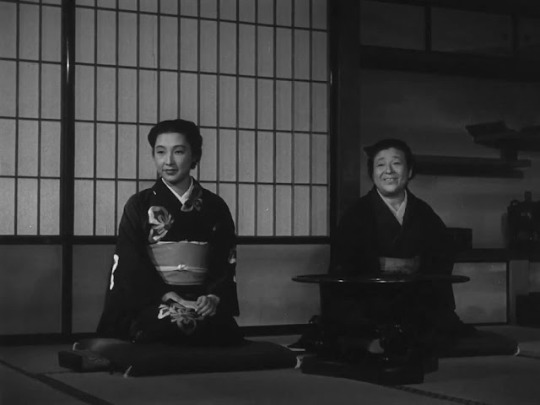
Mieko Takamine and Chieko Higashiyama in The Garden of Women (Keisuke Kinoshita, 1954)
Cast: Mieko Takamine, Hideko Takamine, Keiko Kishi, Yoshiko Kuga, Takahiro Tamura. Masami Taura, Takashi Miki, Kuniko Igawa, Yoko Mochizuki, Chieko Higashiyama, Kikue Mori. Screenplay: Keisuke Kinoshita, based on a story by Tomoji Abe. Cinematography: Hiroshi Kusuda. Art direction: Kimihiko Nakamura. Film editing: Yoshi Sugihara. Music: Chuji Kinoshita.
Youth rebellion films became a prominent genre in Japan, but Keisuke Kinoshita's The Garden of Women is distinctive in that the rebels are all women. They have a lot to rebel against: They are students in a hidebound women's college more determined to turn them into proper young ladies than into educated women. This causes difficulties for Yoshie Izushi (Hideko Takamine), who is a few years older than her fellow students. Most of them come from wealthy families, but Yoshie had to work for several years to earn enough money for the tuition. She wants an education that would make her a fitting partner for her upwardly mobile boyfriend, Sankichi (Takahiro Tamura). But she struggles with some subjects, especially math, and when she tries to study after hours she comes up against school rules that forbid her from studying anywhere except in her room -- which is usually filled with her roommates' friends, who are plotting against the stern headmistress, Mayumi Gojo (Mieko Takamine), aka "The Shrew." Yoshie wants no part of the rebellion: She wants to graduate and marry Sankichi before her family forces her into marriage with a wealthy man of their choosing. Eventually, the student rebellion succeeds, but Yoshie gets caught in the crossfire. The Garden of Women is one of Kinoshita's more successful films, mostly because it gives us an unexplored angle on Japanese society and its tumultuous postwar society. But it's somewhat overplotted, with a few too many characters whose stories take away from the central narrative.
0 notes
Photo

Chieko Higashiyama, Kuniko Miyake, and Ichiro Sugai in The Portrait (Keisuke Kinoshita, 1948)
Cast: Kuniko Igawa, Eitaro Ozawa, Kamatari Fujiwara, Ichiro Sugai, Chieko Higashiyama, Kuniko Miyake, Yoko Katsuragi, Mitsuko Miura, Keiji Sada, Toru Abe. Screenplay: Akira Kurosawa. Cinematography: Hiroshi Kusuda. Production design: Motoji Kojima. Film editing: Yoshi Sugihara. Music: Chuji Kinoshita.
Keisuke Kinoshita's The Portrait deserves to be a little better known, if only because its screenplay is by Akira Kurosawa. Not that it's a masterpiece, or even a particularly felicitous example of Kurosawa's screenwriting, but it's one of the better films of the enormously prolific and sometimes misguided Kinoshita. At the core of the film is an old trope: the portrait that reveals the truth. In this case, it reminds Midori (Kuniko Igawa), the mistress of real-estate hustler Kaneko (Eitaro Ozawa), of her innocent past, causing her to break off their relationship. Kaneko has entered into partnership with Tamai (Kamatari Fujiwara) to buy a rather rundown and ill-planned house, make some renovations, and flip it for double the price. The problem is the tenants, an artist named Nomura (Ichiro Sugai) and his family. Kaneko is reluctant to evict them outright -- this guy is in real estate? -- so he concocts a plan: He will move Midori, who has somewhat of a temper, into the upstairs room of the house, and she'll prove such a torment to Nomura and his family that they'll be glad to leave. But things start to go awry almost immediately: The family think that Midori is Kuneko's daughter instead of his mistress. Naturally, she's somewhat flattered by this misconception. She softens even more when Nomura wants to paint her portrait, and falls completely when the family downstairs prove to be kind and affectionate people. Watching Yoko (Yoko Katsuragi), the daughter, dance with her boyfriend under a full moon, and then be joined by Nomura and his wife, Midori starts to turn against Kaneko. But then even Kaneko is softened by the tenants and abandons his scheme. This is typical movie sentimentality, a fault Kinoshita (and sometimes Kurosawa) was often guilty of, but there is a bittersweet touch to the ending when Midori, having seen her portrait on display at a museum, walks away into an unknown future.
1 note
·
View note
Photo

Toshiko Kobayashi and Hideko Takamine in Carmen Comes Home (Keisuke Kinoshita, 1951)
Cast: Hideko Takamine, Shuji Sano, Chishu Ryo, Toshiko Kobayashi, Kuniko Igawa, Takeshi Sakamoto, Bontaro Miake, Keiji Sada, Yuko Mochizuki. Screenplay: Keisuke Kinoshita. Cinematography: Hiroshi Kusuda. Production design: Motoji Kojima. Film editing: Yoshi Sugihara. Music: Chuji Kinoshita, Toshiro Mayuzumi.
Two giddy Tokyo showgirls descend upon a Japanese village, the birthplace of one of them, Kin Aoyama, whose stage name is Lily Carmen. She's played by the emerging Japanese superstar Hideko Takamine, and her friend, Maya Akemi, by Toshiko Kobayashi. Naturally, their big-city style turns the village upside down, especially when they decide to put on a show and the town learns that they're not just "dancers" but strippers. This first Japanese feature in color was a huge hit, spawning a sequel, Carmen's Innocent Love (Keisuke Kinoshita, 1952), firmly establishing Takamine's stardom, and accelerating writer-director Kinoshita's extraordinarily prolific career.
0 notes
Text
Revelados más vestuarios para la obra de teatro de ‘Shigatsu wa Kimi no Uso’
La obra tendrá funciones en el teatro AiiA 2.5 Theater Tokyo del 24 de agosto, a la 3 de septiembre.

El equipo de producción de la próxima obra de teatro adaptación del Manga de Shigatsu wa Kimi no Uso por Naoshi Arakawa, ha revelado el sábado más vestuarios para su reparto principal:
Reparto más vestuarios actualizado:
Shintarou Anzai como Kousei Arima

Arisa Matsunaga como Kaori Miyazono

Misato Kawauchi como Tsubaki Sawabe, la amiga de la infancia de Kousei.

Masanari Wada como Ryouta Watari, el amigo de la infancia de Kousei Tsubaki que es popular con las mujeres.

Haruka Yamashita como Emi Igawa, una chica que comenzó a tocar el piano porque se fijo en Kousei

Shoujirou Yokoi como Takeshi Aiza, un pianista de primera clase.

Además, la web reveló a más miembros del reparto:
Takako Nakamura como Yuriko Ochiai
Shun Mikami como Akira Takayanagi
Haruka Igarashi como Nao Kashiwagi
Kuniko Kodama como Hiroko Seto
Ryōko Tanaka como Saki Arima
La obra tendrá funciones en el teatro AiiA 2.5 Theater Tokyo del 24 de agosto, a la 3 de septiembre, y en el teatro Umeda Arts Theater in Osaka del 7, al 10 de septiembre. Naohiro Ise esta dirigiendo la obra, y Kaori Miura esta escribiendo el guión.
Kousei Arima es un joven prodigio en tocar el piano que perdió esa habilidad cuando su madre murió. Su vida diaria era en blanco y negro, pero esta comienza a ganar color cuando se encuentra con una hermosa violinista por casualidad llamada Kaori Miyazono una chica brillante y audaz que está rebosante de personalidad. Ambos trabajaran juntos en el mundo de la música a su propio ritmo.
El Anime para televisión de Shigatsu wa Kimi no Uso fue estrenado en Octubre del 2014 y contó con un total de 22 capítulos mas una OVA en mayo del 2015. El Manga original fue publicado en la revista Monthly Shonen Magazine en 2011 y fue finalizado en febrero del 2014. Una película live-action adaptación del Manga se estrenó en septiembre del 2016.
51 notes
·
View notes